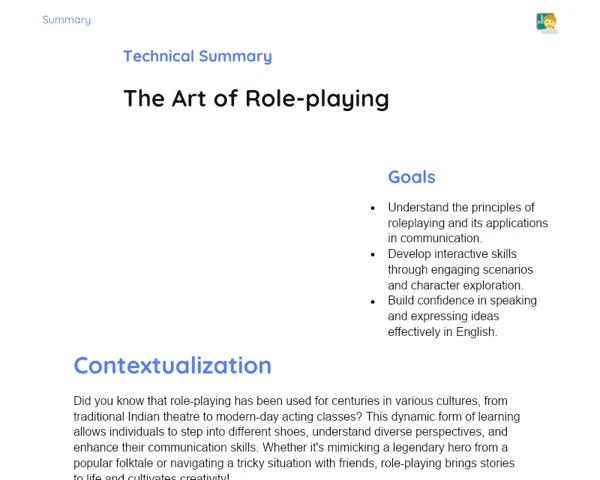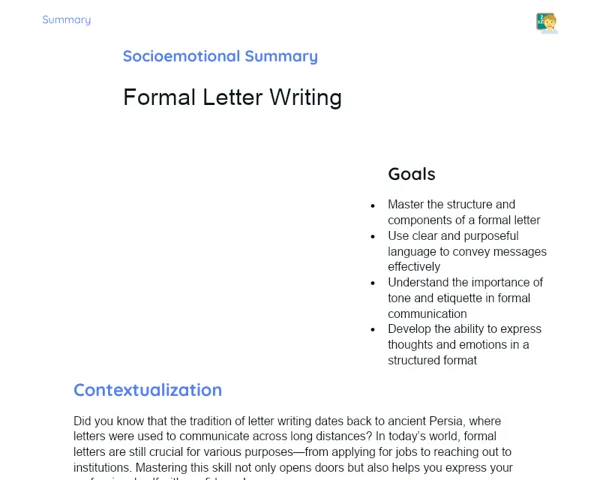Summary Tradisional | Word Pronunciation
Contextualization
Getting the pronunciation of English words right is vital for clear understanding and effective communication. Unlike Portuguese, which has more straightforward pronunciation rules, English can be quite tricky due to its various nuances. Mastering short and long vowel sounds, voiced and voiceless consonants, digraphs, stressed syllables, and intonation is essential for speaking English clearly and understandably.
The significance of pronunciation becomes evident in everyday scenarios like traveling, enjoying English media, and interacting online. By grasping and practicing these elements, students can communicate with more confidence and clarity, minimizing misunderstandings and enhancing their interactions with native speakers. During our lessons, we explore specific techniques to improve pronunciation skills, making this foundational aspect of language learning more accessible.
To Remember!
Short and Long Vowel Sounds
Short and long vowels in English are key in differentiating words. The length of a vowel sound can change the meaning of a word entirely. For instance, 'ship' (/ʃɪp/) has a short vowel, while 'sheep' (/ʃiːp/) features a long vowel. This subtle but important difference plays a major role in how well we communicate.
Furthermore, long vowels typically last longer and might have a different intonation. This can be particularly challenging for Portuguese speakers since vowel duration isn’t always a crucial factor in our language. Practicing these vowel sounds in various contexts aids in internalizing the subtle distinctions and enhances both listening and speaking skills.
Additionally, short vowels are often found in shorter words or unstressed syllables, while long vowels usually appear in longer words or stressed syllables. Practicing such words within full sentences can help better understand the rhythm and intonation of English.
-
Short vowels have a shorter duration, like in 'ship' (/ʃɪp/).
-
Long vowels have an extended duration, as seen in 'sheep' (/ʃiːp/).
-
The duration of vowels can completely change a word's meaning.
Voiced and Voiceless Consonants
Voiced and voiceless consonants differ based on whether the vocal cords vibrate. For voiced consonants, like 'b' in 'bat' (/bæt/), you can feel the vibration, while in voiceless consonants, like 'p' in 'pat' (/pæt/), there is none. This distinction is crucial for pronouncing words correctly and ensuring clear communication.
To practice differentiating these sounds, it helps to feel the vibration in your throat. Placing a hand on your throat while speaking can indicate whether there’s vibration (voiced) or not (voiceless). This method is particularly beneficial for beginners learning English.
Moreover, confusion between voiced and voiceless sounds can lead to misunderstandings. For example, 'dog' (/dɒɡ/) and 'dock' (/dɒk/) convey entirely different meanings. Practicing these words in various contexts strengthens understanding and helps avoid common pronunciation errors.
-
Voiced consonants create vibrations, as in 'b' for 'bat' (/bæt/).
-
Voiceless consonants lack vibration, as in 'p' for 'pat' (/pæt/).
-
Identifying vocal cord vibration is key to distinguishing these sounds.
Digraphs
Digraphs consist of two letters that produce a single sound. Common English digraphs include 'ch', 'sh', and 'th'. For example, 'ch' in 'chip' (/tʃɪp/), 'sh' in 'ship' (/ʃɪp/), and 'th' in 'this' (/ðɪs/). These sounds represent a unique phonetic value rather than simply combining their individual letters' sounds.
Understanding and practicing digraphs is vital for proper pronunciation and fluency in reading. When faced with new words, spotting digraphs can aid in quickly determining how to pronounce them. This is especially useful for more complex texts and words that don’t adhere to standard phonetic patterns.
Practicing reading and pronouncing digraphs across different contexts helps reinforce these sounds. Additionally, listening to native speakers and mimicking their phrases can lead to greater pronunciation accuracy, enhancing effective communication.
-
Digraphs produce a single sound, for instance, 'ch' in 'chip' (/tʃɪp/).
-
They are crucial for accurate pronunciation and reading fluency.
-
Spotting digraphs aids in decoding the pronunciation of new words.
Stressed Syllables
The stressed syllable is the part of a word that gets the most emphasis. In English, the placement of stress can alter the meaning of a word. For instance, 'record' as a verb (to record) emphasizes the second syllable (/rɪˈkɔːd/), while as a noun (a record), the first syllable is stressed (/ˈrekɔːd/). This difference is vital for understanding the intended message.
Practicing how to identify and pronounce stressed syllables involves keenly listening to the intonation of native speakers and repeating words and phrases. Highlighting stressed syllables in written text can help visually reinforce correct emphasis. This practice is particularly important in public speaking settings, such as presentations.
Moreover, intonation and rhythm are significantly shaped by which syllable is stressed. Correct pronunciation contributes to fluency and gives speech a natural feel. Practicing with a variety of words and phrases will help solidify the identification of stressed syllables, thereby enhancing communication skills.
-
The stressed syllable is emphasized more in a word.
-
Changing the stressed syllable can modify the meaning of a word.
-
Focusing on both intonation and rhythm regarding stressed syllables boosts fluency.
Intonation and Rhythm
Intonation is all about how pitch varies while speaking, and rhythm refers to the pattern of speech timing. In English, changes in intonation can alter a sentence's meaning. For example, a rising intonation at the end of a sentence typically signals a question ('Are you coming?'), while a falling intonation conveys a statement ('You are coming.').
The rhythm of English also plays a key role in effective communication, often more rapid and patterned, placing emphasis on particular words within a sentence. Practicing with common phrases enhances fluency and naturalness in speech, which is vital in both social and professional interactions.
Additionally, listening to and attempting to replicate phrases spoken by native speakers can help with mastering intonation and rhythm. This practice improves listening skills while facilitating better spoken production. Continuous practice and correction of frequent mistakes will contribute to clearer and more effective communication.
-
Intonation can change pitch during speech, indicating questions or statements.
-
Rhythm relates to the timing of speech, highlighting certain words.
-
Practicing with common phrases enhances fluency and natural speech.
Key Terms
-
English Pronunciation
-
Short and Long Vowels
-
Voiced and Voiceless Consonants
-
Digraphs
-
Stressed Syllables
-
Intonation
-
Rhythm
-
Effective Communication
Important Conclusions
Getting pronunciation right in English is key to clear and effective communication. Throughout our lessons, we highlighted the need to differentiate between short and long vowels, voiced and voiceless consonants, digraphs, stressed syllables, as well as intonation and rhythm in speech. Mastering these elements is fundamental for avoiding misunderstandings and fostering better communication among English speakers.
Recognizing the significance of particular sounds, such as short versus long vowels or voiced versus voiceless consonants, can dramatically alter word meanings. This underscores the need for ongoing practice and attention. Identifying and accurately pronouncing digraphs while placing emphasis on stressed syllables and intonation is essential for achieving fluency and naturalness in spoken English.
We encourage students to keep exploring and practicing these crucial pronunciation elements. Regular practice and exposure to native speakers are effective strategies for building these skills, which ultimately lead to more confident and successful communication in various situations, from traveling to online interactions and enjoying English media.
Study Tips
-
Practice pronunciation by listening to and repeating words and phrases from native speakers. Utilize resources like English videos, music, and podcasts.
-
Record your own voice while practicing pronunciation and compare it with native speakers. This will help identify areas that need work.
-
Leverage apps and online platforms focusing on pronunciation and error correction. Interactive tools can provide quick feedback and support.


